Asclepias

Milkweed is the common name for many plants in the genus, Asclepias. In the northeast, there are five different perennial species of milkweed growing wild: butterfly weed (A. tuberosa), common milkweed (A. syriaca), poke milkweed (A. exaltata), swamp milkweed (A. incarnata), and whorled milkweed (A. verticillata). All are suitable hosts for the monarch and many other caterpillars and insects.
The association of the monarch butterfly and the milkweed plant is pretty well-known. This is because the monarch butterfly will only lay its eggs on Asclepias species, which are the only host plants of its caterpillar. Milkweeds also serve as a nectar source for many butterflies and many other pollinator insect species, and for this reason, milkweeds are great plants to include in both butterfly and pollinator gardens.
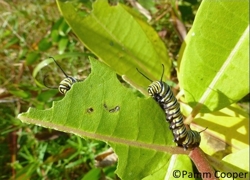
Two monarch caterpillars on common milkweed
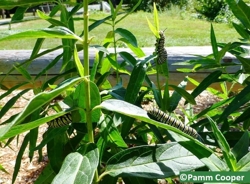
Several monarch caterpillars on swamp milkweed
All milkweeds contain a milky sap which can be seen if the stem or leaf is broken. Within the sap is a toxin, cardiac glycosides, causing poisoning of humans and animals if eaten. Some insects have evolved over time to become adapted to feeding on these toxins, and the insects become poisonous to the predators that eat them. The insects have developed a way to take the toxins from the milkweed while eating the leaves and sap, and use the toxins as a defense mechanism against birds, animals and other insects that want to use them as a food source.
Site Selection
Milkweed plants will grow in slightly acidic soil with a pH range from 4.8 to 6.8. They are hardy in zones 3-8. Milkweed plants require full sun and a lot of space and should be placed at the back of flower beds as they can grow to 3 feet tall. The planting site should be chosen carefully as milkweed is difficult to transplant.
Planting
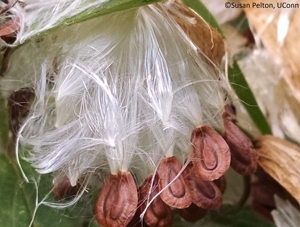 Milkweed can be grown from seed or transplants. The seeds of Asclepias develop in large green pods that turn brown when seeds have matured. The seeds are arranged in rows that overlap and each pod may contain hundreds of seeds. Each seed has filaments attached to it that enable it to waft on the wind. Milkweed seeds should be harvested at a particular stage of pod opening to ensure seeds are viable. Pods should be brown, dry and open, or open when pinched at the seam. Since milkweeds are clonal, collect seeds of the same species from different areas to ensure genetic diversity.
Milkweed can be grown from seed or transplants. The seeds of Asclepias develop in large green pods that turn brown when seeds have matured. The seeds are arranged in rows that overlap and each pod may contain hundreds of seeds. Each seed has filaments attached to it that enable it to waft on the wind. Milkweed seeds should be harvested at a particular stage of pod opening to ensure seeds are viable. Pods should be brown, dry and open, or open when pinched at the seam. Since milkweeds are clonal, collect seeds of the same species from different areas to ensure genetic diversity.
The seeds of the Asclepias plant must undergo a process called stratification in order to germinate. To stratify milkweed seeds:
- Remove the filaments from the seed.
- Place the cleaned seeds into moist soil in a pot or between moist paper towels in a plastic bag.
- Place it in a cold spot in the refrigerator for 3 weeks to 3 months.
- Direct sow these seeds in the spring or start indoors 4-6 weeks before the seedlings will go outside.
- When the seedlings have 4 true leaves they can be transplanted.
- Seeds may also be planted directly in the ground in late fall.
- Space plants 1-2 feet apart.
Some Common Asclepias Varieties
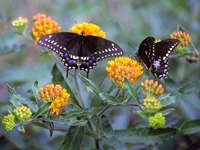
Butterfly weed, (A. tuberosa) has orange flowers and prefers to grow in dry, gravel laden soil in full sun. It is a very drought tolerant native. Plants grows one to two and half feet tall on thick, hairy stems with lanceolate shaped leaves arranged alternately. The leaves are about one inch wide and three and half inches long. The many small, orange flowers are grouped into an umbel, giving a splash of bright color in the wild or when planted in a garden. This milkweed has a large taproot that once the plant is mature, will send out side roots to create new plants off of the original mother plant. Butterfly weed does not produce the milky sap in its leaves, so it is not commonly called a milkweed just butterfly weed, even though it is in the Asclepias genus. It is a butterfly magnet. Recommended pH is 5.6 to 7.5.
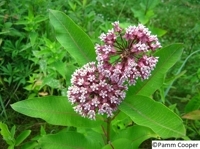
Common milkweed (A. syriaca) is aptly named as it is the most widely found milkweed in North America. It grows a strong, three foot stem and pink flower. It can be found in sunny meadows and wastelands with well drained soils. Its rhizomes spread horizontally and clonally creating large clumps of populations, and for this reason it is very difficult to successfully transplant this milkweed. One plant can have a very large root system and many stems. Its sweet scented flower attracts many butterflies and pollinators. Monarchs are a common site as well as great spangled fritillaries, red admirals, Baltimore checkerspots, coral hairstreaks and other native butterflies. Milkweed beetles and milkweed bugs are an almost constant presence on the common milkweed plant.
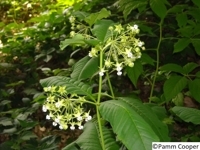 Poke milkweed (A. exaltata), flowers are white to lavender umbels. The umbels weep downward with flowers hanging down on distinct light green, two and half inch long petioles. The striking flower formation is very open compared to the tightly held flower formation the other milkweeds. Seed pods are held in an upright fashion, forming after flowering for about four weeks during the summer. Flowers are very strongly scented when in full bloom. Poke milkweed can be found on forest edges with moist, dappled shade conditions.
Poke milkweed (A. exaltata), flowers are white to lavender umbels. The umbels weep downward with flowers hanging down on distinct light green, two and half inch long petioles. The striking flower formation is very open compared to the tightly held flower formation the other milkweeds. Seed pods are held in an upright fashion, forming after flowering for about four weeks during the summer. Flowers are very strongly scented when in full bloom. Poke milkweed can be found on forest edges with moist, dappled shade conditions.
 Swamp milkweed (A. incarnata), the species’ name ‘incarnata’ is from Latin meaning flesh-colored, describing the rosy flesh color of the flower. Swamp milkweed can be found in moist areas with sunny openings such as swamps, marshes, stream banks and other fresh water edges. It is suitable for gardens where it will not dry out. The leaf of the swamp milkweed is a narrow lance shape, different than the wider, rounder shape of the common milkweed’s leaf. The seed pod of swamp milkweed is also long and elegantly narrow. Recommended pH is 5.8 to 6.8
Swamp milkweed (A. incarnata), the species’ name ‘incarnata’ is from Latin meaning flesh-colored, describing the rosy flesh color of the flower. Swamp milkweed can be found in moist areas with sunny openings such as swamps, marshes, stream banks and other fresh water edges. It is suitable for gardens where it will not dry out. The leaf of the swamp milkweed is a narrow lance shape, different than the wider, rounder shape of the common milkweed’s leaf. The seed pod of swamp milkweed is also long and elegantly narrow. Recommended pH is 5.8 to 6.8
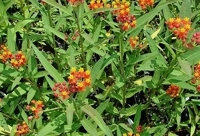 Tropical Milkweed, (A. curassavica), can be planted as an annual in areas with cold winters. It is a great container plant placed on decks, in hanging planters or patio gardens to observe the many butterflies and nectar feeding insects that will visit the orange, red and sometimes yellow flowers. Tropical milkweed will not live through our winters and dies with the first frost. Potted plants are available at garden centers, or start your own plants easily from seed inside in early spring. It is a long bloomer, but will not keep monarchs from migrating as some have previously reported in hot season climates. Place in a full sun location for flowers all summer into early fall.
Tropical Milkweed, (A. curassavica), can be planted as an annual in areas with cold winters. It is a great container plant placed on decks, in hanging planters or patio gardens to observe the many butterflies and nectar feeding insects that will visit the orange, red and sometimes yellow flowers. Tropical milkweed will not live through our winters and dies with the first frost. Potted plants are available at garden centers, or start your own plants easily from seed inside in early spring. It is a long bloomer, but will not keep monarchs from migrating as some have previously reported in hot season climates. Place in a full sun location for flowers all summer into early fall.
 Whorled Milkweed (A. verticillata) prefers to prairies, meadows and open sunny areas, often growing alongside wild grasses in ditches and wastelands. Whorled milkweed has very narrow, two to three inch long leaves occurring in whorled groups of four to six on the erect, two foot tall stems. When not in flower, the green leaves and stems almost look like grass plants. Umbels of white to greenish flowers are borne at the center leaf axis of the upper leaf whorls. Each umbel consists of seven to twenty individual flowers. Each flower is hooded has five petals and five hoods with horns. Brown seed pods are long and narrow.
Whorled Milkweed (A. verticillata) prefers to prairies, meadows and open sunny areas, often growing alongside wild grasses in ditches and wastelands. Whorled milkweed has very narrow, two to three inch long leaves occurring in whorled groups of four to six on the erect, two foot tall stems. When not in flower, the green leaves and stems almost look like grass plants. Umbels of white to greenish flowers are borne at the center leaf axis of the upper leaf whorls. Each umbel consists of seven to twenty individual flowers. Each flower is hooded has five petals and five hoods with horns. Brown seed pods are long and narrow.
Insects Associated with Milkweeds
Most insects that feed on the milkweed plant reap the benefits of the alkaloid toxin sap, storing it in their bodies to protect them against predators. Many of them have bright orange-red and black markings that also serve as a warning to shared predators.
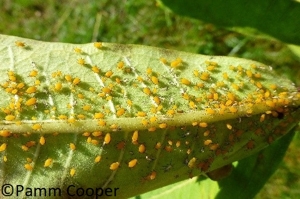
Aphid-There are several aphids that are pests to Asclepias the most common is the yellow milkweed aphid. These piercing and sucking insects will feed on the plant's sap and excrete the liquid called honeydew that may attract ants which harvest the honeydew. Do not confuse the bright yellow milkweed aphid, which will be mobile, with the eggs of the Monarch butterfly, which will be stationary and are generally laid in large groups.
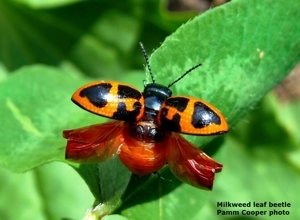
Milkweed leaf beetle (Tetraopes tetrophthalmus)-1/3-2/3" long. A bright orange-red long-horned beetle with black spots. It overwinters in the soil in the larval stage feeding within the milkweed root. They pupate in the spring in earthen chambers and emerge as adults in early summer. As adults they feed on the leaves, buds, and flowers.
Large Milkweed bug (Oncopeltus fasciatus)-3/4" long adults are bright orange-red with black wing pads and a black band across the back. Feed mid-late summer. Migrate south at the end of the season. No significant harm to the plants.
Large Milkweed bug (Oncopeltus fasciatus)-3/4" long adults are bright orange-red with black wing pads and a black band across the back. Feed mid-late summer. Migrate south at the end of the season. No significant harm to the plants.
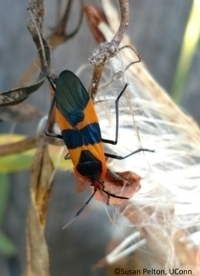
Large milkweed bug
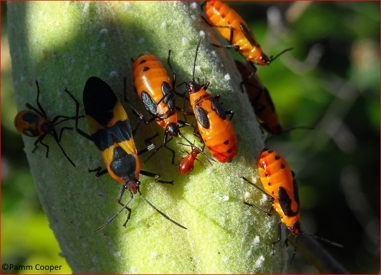
Large milkweed bug-adults and nymphs
Lesser (small) Milkweed bug (Lygaeus kalmii)-1/2 " long adults have an orange-red X on a black background. It is often mistaken for the Boxelder bug. It overwinters as an adult or nymph. No significant harm to the plants.
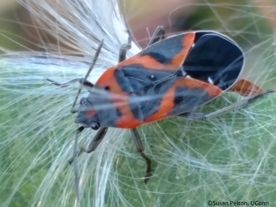
Lesser milkweed bug
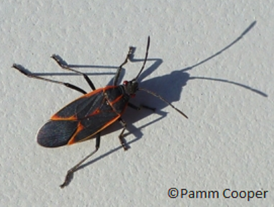
Boxelder bug
Milkweed tussock moth (Euchaetes egle)-The orange, black and white caterpillar of the Milkweed tussock moth will be found feeding in groups of up to 10 larvae where the Monarch caterpillar is generally a solitary feeder. These caterpillars have long tufts of white and black hair along their bodies and at the ends.
Milkweed Toxicity to Livestock
(Prepared by Joyce Meader, UConn Extension Dairy/Livestock Educator)
Animals usually do not eat milkweed unless good forage is scarce. The milky white sap is sticky and has a bitter taste but livestock will eat the topmost, tender leaves if good forage is not abundant. While the fresh, green plant material is the most toxic, dried plants present in pastures or hay retain their toxicity. Cardiac glycosides are found in the majority of milkweed species, while a neurotoxin is specific to the whorled-leaf types. Of the two, the neurotoxin is the most lethal. Milkweed can be controlled with 1.5% glyphosate as a spot spray when plants have reached the late bud to flower stage of growth (will kill grasses as well).
- Toxicity Rating: Low to moderate. Milkweed are unpalatable and have variable toxicities. Death is not likely unless large quantities are consumed.
- Animals Affected: All animals may be affected. Sheep are most at risk, but cattle, goats, horses, poultry, and pets are also at risk.
- Dangerous Parts of Plant: Stems, leaves, roots.
- Class of Signs: Gastrointestinal irritation (primarily vomiting and diarrhea), incoordination, tremors, heart problems, respiratory difficulty, death.
Despite good cultural practices, pests and diseases at times may appear. Chemical control should be used only after all other methods have failed.
For pesticide information or other questions please call toll free: 877-486-6271.
UConn Home and Garden Education Center, 2018
